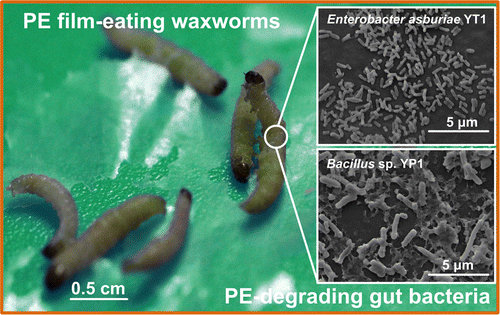Everyone knows that plastic materials remain in the environment for many years without decomposing, which contributes significantly to the amounts of waste and the number of landfills required for it. However, scientists have now discovered that a bacterium originating from the intestines of a worm that feeds on food packaging can break down the material polyethylene - the most common component in the plastic industry.

[Translation by Dr. Nachmani Moshe]
Scientists discovered a long time ago that a bacterium originating from the intestines of a worm that feeds on food packaging can break down the material polyethylene - the most common component in the plastic industry. The findings could lead to the development of new ways to get rid of this persistent waste, the researchers explain.
Everyone knows that plastic materials remain in the environment for many years without decomposing, which contributes significantly to the amounts of waste and the number of landfills required for it. However, scientists have now discovered that a bacterium originating from the intestines of a worm that feeds on food packaging can break down the material polyethylene - the most common component in the plastic industry. The findings, published in the scientific journal Environmental Science & Technology, could lead to the development of new ways to get rid of this persistent waste, the researchers explain.
The lead researcher and his colleagues point out that the global plastic industry produces an amount of 140 million tons of polyethylene every year. Most of the material is used for the production of bags, bottles and boxes that many of us use every day - and throw them away at the end of use. For many years scientists have been trying to find a way to get rid of this waste. Some of the most up-to-date research in this field is based on the attempt to activate bacteria against the plastic materials in order to break them down, however, these experiments require the plastic to be exposed to light or heat beforehand. The current researchers wanted to find a bacterium that could break down polyethylene in a single step.
They turned to plastic-eating moth larvae known as waxworms. They discovered that at least two strains of bacteria originating from the intestines of this type of worms are capable of breaking down polyethylene without needing a preliminary step. The scientists claim that their findings indicate a new and more direct way to biodegrade plastic materials.
The article was published with the permission of Scientific American Israel

4 תגובות
Boring
The question is what is the product of this decomposition and what is its effect on the environment?
"The lead researcher and his colleagues point out that the global plastic industry produces an amount of 140 million polyethylene every year. "
Probably the reference is to millions of tons, it is recommended above the article or the translator, to read it before publication and thus avoid creating an impression of disdain.
worm?
I would have expected a slightly more respectable translation, as befits a scientific website
This is the larva of the mealybug butterfly Plodia interpunctella from the family of the weevils from the order of insects in the arthropod system.
Worms constitute their own system (or rather 3 systems) and have no systematic relationship to insects except for the fact that they are all invertebrates.
If you don't want to get into complicated scientific terms, you could just use the term "caterpillar"
Also, the use of the term "variety" is out of place. The translation for species is "min"
The term "breed" describes variations of a particular species developed by man. Like varieties of roses or apples